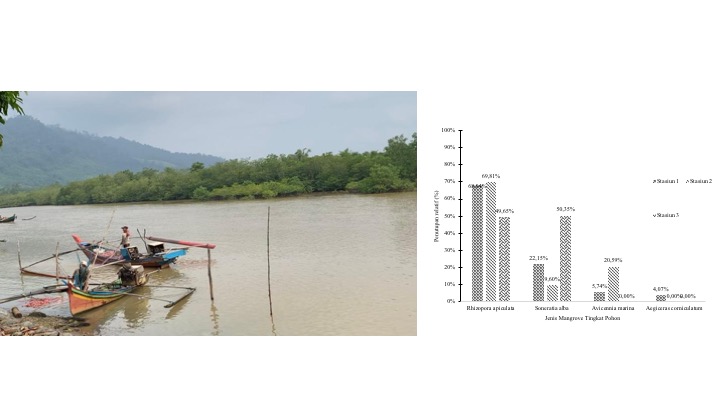Community Structure and Mangrove Canopy Cover in the SFV (Smart Fisheries Village) Area of West Pasaman
DOI:
https://doi.org/10.46252/jsai-fpik-unipa.2024.Vol.8.No.4.474Keywords:
Community Structure, Mangrove Ecosystem, SFV, West PasamanAbstract
Mangrove forests are tropical and subtropical coastal vegetation communities that can grow and develop in muddy coastal intertidal areas. This study aimed to identify and analyze the structure and canopy cover of mangrove ecosystems in SFV (Smart Fisheries Village). The research was conducted using a survey method. The observation station was determined by purposive sampling method. Data analysis was done using descriptive statistical methods. Mangroves in SFV (Smart Fisheries Village) West Pasaman are Avicennia marina, Rhizophora apiculata, Sonneratia alba, and Aegiceras corniculatum. The highest density of mangrove trees, saplings, and seedlings are 500 Ind/ha, 3866.67 Ind/ha, and 66666.67 Ind/ha with mangrove species Rhizophora apiculata. The highest frequency of tree category species with Rhizophora apiculata species is at stations 1, 2, 3 and Soneratia alba at stations 1 and 3. The highest frequency of seedling category species is Rhizophora apiculata at all three stations, Soneratia alba at station 3, and Avicennia marina at station 2. The highest frequency of seedling category species at all three stations is Rhizophora apiculata and Soneratia alba at station 3. The highest mangrove species cover is Rhizophora apiculata at stations 1 and 2 with a value of 68.04% (station 1), 69. 81%, (Station 2), and Soneratia alba 50, 35%, (Station 3) The index of important value (INP) of mangroves at the level of trees, saplings, and seedlings is highest in the species Rhizophora apiculata successively at all stations The value of diversity index (H') is categorized as low, while the dominance index is categorized as moderate. The percentage of mangrove canopy cover is classified as mild.
Downloads
References
Agustini, N. T., Ta’alidin, Z., dan Purnama, D. (2016). Struktur komunitas mangrove di desa Kahyapu Pulau Enggano. Jurnal Enggano, 1(1), 19-31.
Azman, A., Kevin, K.S., Lee, C.T., dan Tnah, L.H. (2020). Low Genetic Diversity Indicating the Threatened Status of Rhizophora apiculata (Rhizophoraceae) In Malaysia: Declined Evolution Meets Habitat Destruction.
Bengen, D.G. (2000). Pedoman Teknis Pengenalan dan Pengelolaan Ekosistem Mangrove, Pusat Kajian Sumberdaya Pesisir dan Lautan. IPB. Bogor.
Cintron, G., dan Y. S. Novelli. (1984). Methods for Studying Mangrove Structure. Dalam Editor Snedaker, S. C. dan Snedaker, J. S. The Mangrove Ecosystem: Research Methods. UNESCO, Paris, France.
Dharmawan IWE dan Pramudji. (2014). Panduan Monitoring Kesehatan Ekosistem Mangrove. COREMAP-CTI, Pusat Penelitian Oseanografi, LIPI. Jakarta. 35 pp.
DKP Provinsi Sumatera Barat, (2021). Petunjuk Teknis Penanaman Mangrove.
Eggy, H, P., I. Dewiyanti., dan S. Karina. (2016). Indeks Nilai Penting Vegetasi Mangrove di Kawasan Kualo di Kabupaten Aceh Timur. Jurnal Ilmiah Mahasiswa dan Perikanan Unsyiah. 1(1): 82-95.
Febriansyah. Hartono, D., Negara, B.F.SP., Renta, P.P., dan Sari, Y.P. (2018). Struktur Komunitas Hutan Mangrove di Pulau Baai Kota Bengkulu. Jurnal Enggano. 3(1): 112-128.
Hadi, S. (1980). Metodologi Research. Yogyakarta: Yayasan Penerbit Fakultas Psiokologi Universitas Gajah Mada.
Indriyanto. (2006). Ekologi Hutan. PT. Bumi Aksara, Jakarta.
Kuncahyo, I., Pribadi, R., dan Pratikto, I. (2020). Komposisi dan tutupan kanopi vegetasi mangrove di Perairan Bakauheni, Kabupaten Lampung Selatan. Journal of Marine Research, 9(4), 444-452.
Kustanti, A. (2011). Manajemen Hutan Manggrove. PT Penerbit IPB Press. Bogor.
Mackenzie, S. B, Podzakoff, P.M, Ahearne, M, (1998). some possible antecedent and consequence in the role and extra-role salesperson performance. Journal of Marketing. Vol. 62 p. 87- 98.
Mueller-Dombois, D dan H. Ellenberg. (1974). Aims and Methods of Vegetation Ecology. John Wiley, London.
Mustika, D.I., Rusdiana, O., dan Sukendro, A. (2014). Pertumbuhan Bakau Minyak (Rhizophora apiculata) di Persemaian Mangrove Desa Muara Teluk Naga, Tangerang, Banten. 4 (2): 108-116.
Nontji, A. (2005). Laut Nusantara (Edisi revisi). Djambatan, Jakarta.
Nurfitrian. N., dan Sayida, B.R. (2022). Pengembangan Wilayah Perikanan Berbasis Smart Fisheries Village (SFV) di Desa Pulogading Kecamatan Bulakamba Kabupaten Brebes Provinsi Jawa Tengah. Jurnal Ekonomi Pesisir, 4(2), 1-7.
Nybakken, J.W. (1988). Biologi Laut : Suatu Pendekatan Ekologis. PT. Gramedia Jakarta.
Pemerintah Kabupaten Pasaman Barat. (2009). Laporan Status Lingkungan Hidup Daerah (SLHD) Kabupaten Pasaman Barat Tahun.
Pretzsch, H., Biber, P., UHL, E., Dahlhausen, J., Rötzer, T., Caldentey, J., Koike, T., Van Con, T., Chavanne, A., Seifert, T. and Du Toit, B. (2015). Crown size and growing space requirement of common tree species in urban centers, parks, and forests. Urban forestry and urban greening, 14(3):466-479.
Pribadi, R. (1998). The Ecology of Mangrove Vegetation in Bintuny Bay, Irian Jaya Indonesia. Thesis. Departement of Biological Molecular Sciences. University of Stirling, Scotland.
Purnama, M., Pribadi, R., dan Soenardjo, N. (2020). Analisa tutupan kanopi mangrove dengan metode hemispherical photography di Desa Betahwalang, Kabupaten Demak. Journal of Marine Research, 9(3), 317-325.
Rahman, D. Yanuarita, dan N. Nurdin. (2014). Struktur Komunitas Mangrove di Kabupaten Muna. Jurnal Ilmu Kelautan dan Perikanan. 24(2): 29-36.
Raymond, G., Harahap, N dan Soenarno. (2010). Pengelolaan Hutan Mangrove Berbasis Masyarakat Di Kecamatan Gending, Probolinggo. Agritek, Vol.18 No.2 April 2010 (185-200).
Rumengan A. P., Mantiri D. M. H., Rompas R., Hutahaean A., Kepel T. L., Paruntu C. P., Kepel R. C., Gerung G. S. (2018). Carbon Stock Assessment of Mangrove Ecosystem in Totok Bay, Southeast Minahasa Regency, North Sulawesi, Indonesia. AACL Bioflux. 11 (4) : 1280-1288.
Setyawan, A. D., Indrowuryatno, Wiryanto, K. Winarno, & A. Susilowati. (2005). Tumbuhan Mangrove di Pesisir Jawa Tengah: 1. Keanekaragaman Jenis. Biodiversitas. 6(2): 90-94.
Snedakeer, S.C dan J.G. Snedaker. (1984). The Mangrove Ecosystem. Research Method. New York: UNESCO.
Sofian, A., N. Harahab, dan Marsoedi. (2012). Kondisi dan Manfaat Langsung Ekosistem Mangrove Desa Penunggul Kecamatan Nguling Kabupaten Pasuruan. El-Hayah. 2 (2): 56-63.
Sugiyono. (2017). Metode Penelitian Kuantitatif, Kualitatif, R dan B. Bandung: Alfabeta.
Taufikri, T. (2021). Mapping Tourist Destination Destinations In West Pasaman Regency. JURNAL BUANA, 5(2), 274-281.
Yanti, R. (2021). Komposisi Jenis dan Kerapatan Mangrove di Kawasan Hutan Mangrove Desa Srimonasari Kecamatan Labuhan Maringbai Kabupaten Lampung Timur. Skripsi. Fakultas Tarbiyah dan KeguruanUniversitas Islam Negeri Raden Intan Lampung.

Downloads
Published
How to Cite
Issue
Section
License
Copyright (c) 2024 Aldi Rizki Walqodra, Dewi Purnama, Ari Anggoro, Rizki Anggoro Adi

This work is licensed under a Creative Commons Attribution-ShareAlike 4.0 International License.


















